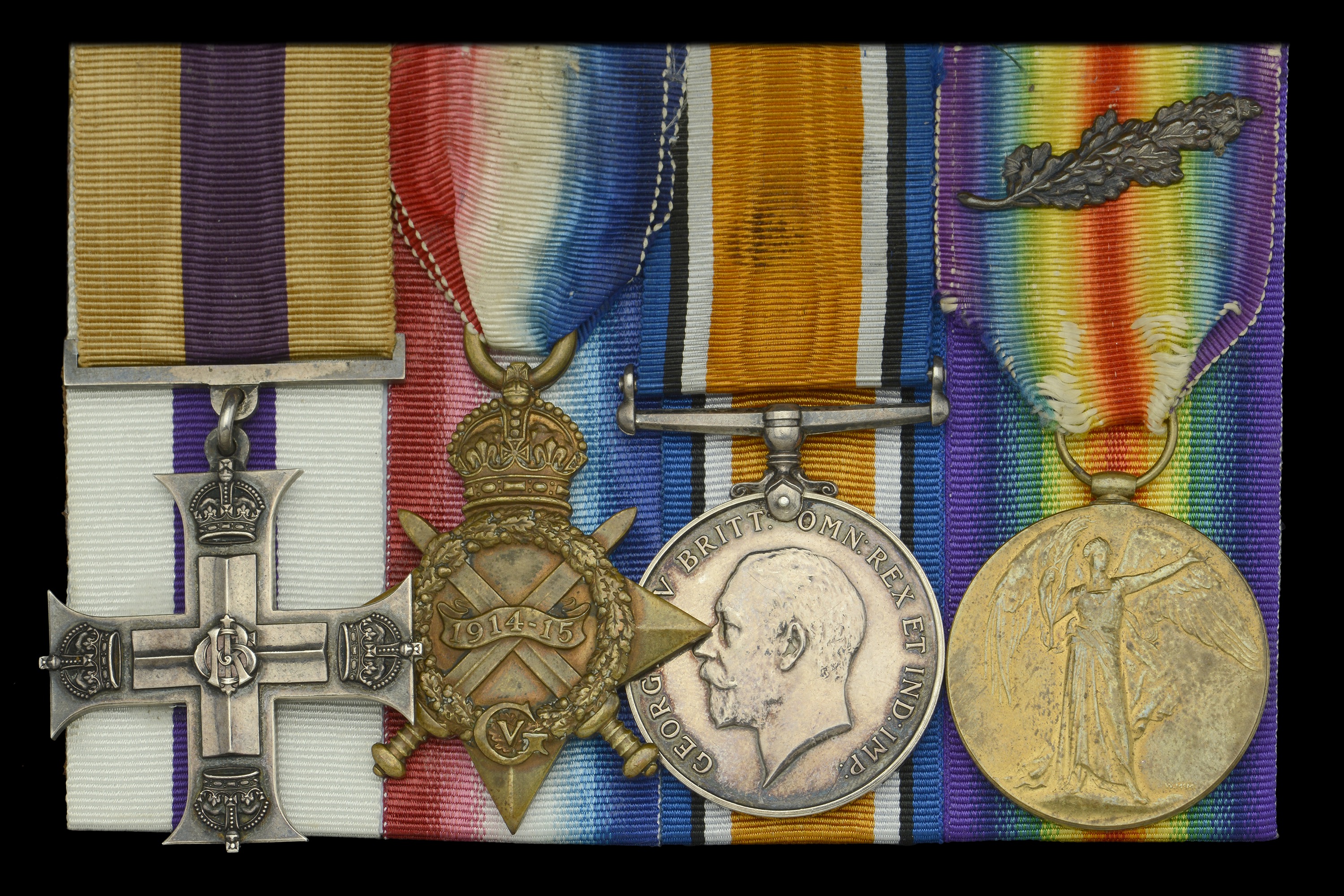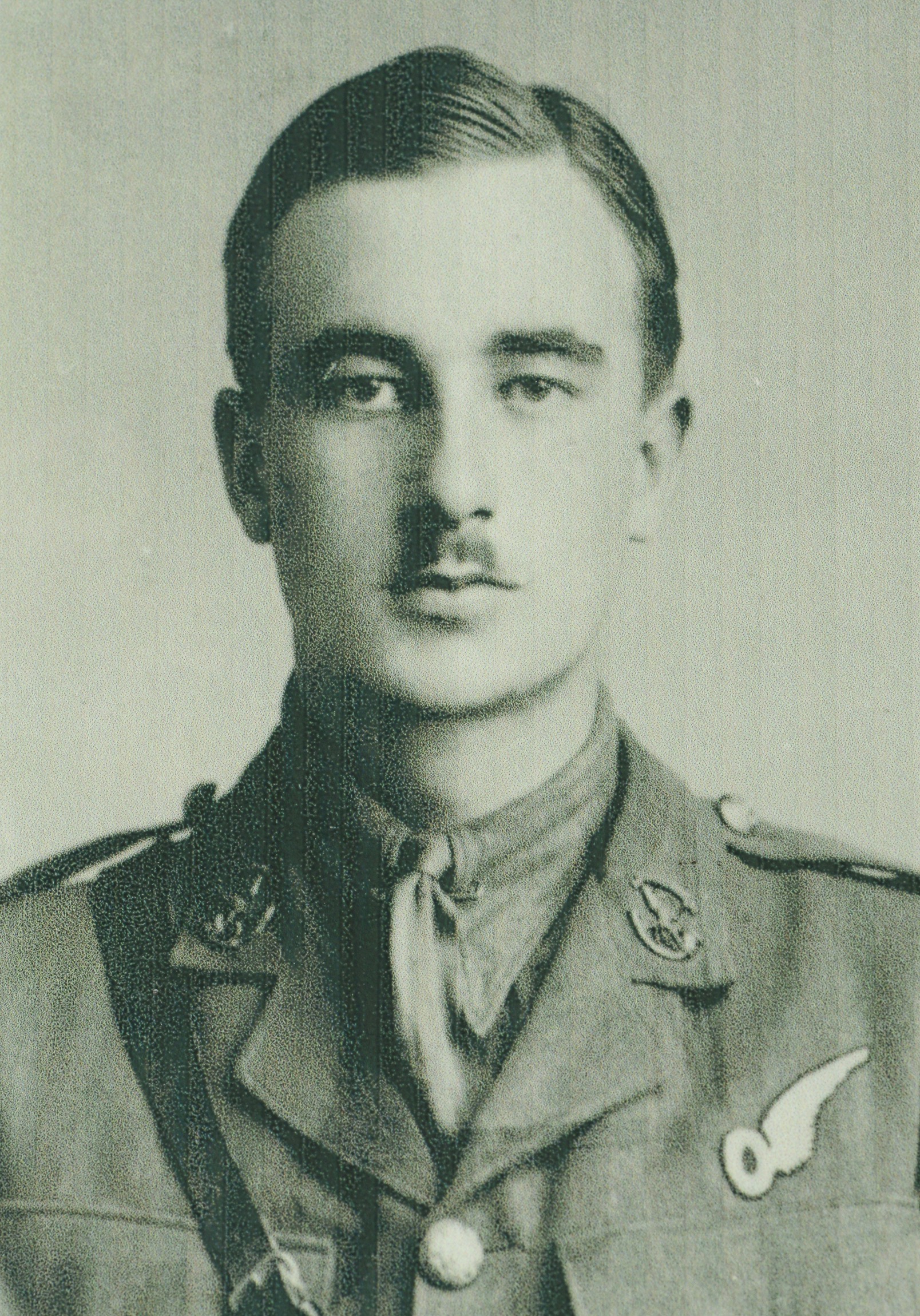‘Terrible trials were averted by those brave airmen, who rose from fog-enveloped aerodromes with little prospect of ever reaching earth again alive. Many a time the report “nothing seen” would be rendered; but seeing nothing themselves they were frequently seen by their prey and so frustrated many a raider. If the list of unknown heroes were being compiled these would assuredly figure amongst the first.’ (The German Air Raids on Great Britain, by Captain J. Morris refers) An early and rare Great War ‘Defence of Great Britain’ M.C. group of four awarded to Captain R. C. L. Holme, Royal Flying Corps, late Somerset Light Infantry, who distinguished himself in the fight against raiding Zeppelins with 39 (Home Defence) Squadron, alongside such pilots as ‘Bomber’ Harris and William Leefe-Robinson. Transferring to 33 Squadron, Holme crashed on take-off whilst attempting to intercept one of the 16 airships intent on raiding London - one of which, SL11, was shot down by Leefe-Robinson during his V.C. winning exploits on 2-3 September 1916. Holme suffered badly both physically and mentally as a result of his crash - having to be removed from underneath his burning aircraft. Despite these setbacks, he went on to be posted to France as a Flight Commander with 29 Squadron and gained ‘Ace’ status in SE.5a single seater fighters during 1918. Holme survived the War, only to tragically die as a result of injuries and burns sustained as a passenger in a Vickers Vernon which crashed in Baghdad in October 1922 Military Cross, G.V.R., unnamed as issued; 1914-15 Star (2. Lieut. R. C. L. Holme. Som. L.I.); British War and Victory Medals, with M.I.D. oak leaves (Capt. R. C. L. Holme. R.A.F.) generally very fine or better (4) £3,000-£4,000 --- Provenance: Dix Noonan Webb, September 2000. M.C. London Gazette 24 January 1917 (Home Honours): ‘For valuable services rendered in connection with the War.’ One of a handful of known ‘Home Defence’ gallantry awards for the Air Defence of Great Britain during the Great War, five of which were awarded in respect of gallantry during 1916 and 1917 - these including a V.C., a D.S.O., a Second Award Bar to the M.C., and 2 M.C.’s (the latter including Holme’s award). These early awards were for actions against Zeppelins, whilst the remainder were primarily for actions against Giants and Gothas in 1918. M.I.D. London Gazette 25 January 1917: ‘For distinguished services rendered in connection with the War.’ Robert Charles Lyon Holme was born in Reading, Berkshire, in November 1896, and in his youth resided in Norton-sub-Hampden, Somerset, and Barnes, London. He was educated at Repton and Sandhurst, and was commissioned into Prince Albert’s Somerset Light Infantry 11 November 1914, the day after his 18th birthday. Holme served with the Regiment in France from December 1914 to March 1915. He transferred to the Royal Flying Corps later that year, and despite being initially seconded as an Observer to 16 Squadron, Holme qualified on a Maurice Farman for Aviator’s Certificate No. 1665 at the British Flying School, Le Crotoy, on 28 August 1915. He had already been in combat with 16 Squadron, with Second Lieutenant H.M. Goode as his pilot, on 17 June 1915. On this date the pair carried out a reconnaissance in a BE.2a over Seclin, armed only with an automatic rifle, when they engaged an Aviatik bi-plane: 'The German machine was first seen going south over Gondecourt, where upon we changed our course in order to get within range – when within about 200 yards we made a sharp turn heading north and opened fire, we followed him as far as Loos firing all the time. By then he had increased his lead to some 1,000 yards and was losing height rapidly, we then turned and continued our reconnaissance. During the later point of the combat we were in range of the Lille anti-aircraft guns which had opened an ineffective fire.' (Combat Report refers) A ‘Dash’ with ‘Bomber’ Harris Holme was officially seconded as a Flying Officer (Observer) in the Royal Flying Corps in September 1915, and left 16 Squadron the same month. He was posted for Home Defence duties, for the defence of Great Britain, in December 1915. Holme carried out further training as a pilot, and served with 39 (Home Defence) Squadron (BE.2cs) at Sutton’s Farm and Hainault Farm, Hounslow. By the start of the new year, he was up in the air trying to intercept Zeppelins: ‘On the night of 25/26 April 1916, one of Holme’s squadron colleagues, Captain A. T. Harris, became the first to use the new and still experimental Brock explosive bullets against a raiding Zeppelin (LZ97). (Harris would gain undying fame in the Second World War as ‘Bomber’ Harris). Soon after closing with LZ97, Harris’ Lewis gun jammed and whilst he was clearing it, the Zeppelin slipped away into the surrounding gloom. Holme and another colleague spied the same Zeppelin in the distance, coned in the light of searchlights, but it was too far away to be caught.’ (The Military Cross to Flying Personnel of Great Britain and the Empire 1914-1919, by H. Giblin and N. Franks refers) Holme, Harris and one Lieutenant W. Leefe-Robinson (later V.C.) had attempted an attack on one of five raiding Zeppelins that night. Both Harris and Leefe-Robinson were unsuccessful, and Holme took up the pursuit. However, he encountered a fuel problem and was forced to make a dead-stick landing at Chingford. Hunting Zeppelins with Leefe-Robinson Holme advanced to Temporary Captain, and transferred as a Flight Commander to 33 Squadron (BE.2cs) at Bramham Moor. The Squadron was engaged on Home Defence duties, protecting the Midlands and the North against Zeppelin raids. On the night of 28-29 July 1916, the Squadron received information from the Humber Garrison Commander that hostile airships (six Imperial Navy Zeppelins) had been sighted 40 miles east of the mouth of the Humber proceeding due west. At this time, however, a thick fog in the vicinity of the aerodrome precluded any attempt being made to despatch aeroplanes. At 2 a.m. a further report was received of a Zeppelin proceeding from Driffield towards Hull. The weather being slightly clearer by this time, Lieutenant Holme was the only pilot to ascend from Bramham Moor, but at 3,500 feet above the aerodrome could barely see the landing flares and as the fog was becoming thicker he was forced to descend. So bad was the weather that he was forced to abandon his attempt to stalk Kapitanleutnant Koch’s L24, which had been reported in the Hull area. On the night of 2-3 August 1916, six Zeppelins raided England, whilst the Squadron was operating from Beverley. Although the German force confined their raid to the eastern counties of Norfolk and Suffolk, 33 Squadron sent out a protective patrol over Hull and the Humber. Holme took off at 2.25 am and patrolled towards Driffield, then turning south he circled round Hull at 10,000 feet. Visibility was bad and he could see nothing on his own level, so descending to 8,000 feet he went out over Hedon to the coast and followed it north to Atwick, where Holmes stated: 'I now saw a searchlight at Beverley giving me the pre-arranged signal that all was over, accordingly I throttled to come down. My lights had gone out and wishing to keep my headlamp until near the ground I came down without it to 4,000 feet. When trying my engine I got into a mild nose dive but came out of it all right and landed without damage at 3.35 am.’ Exactly one month later, on the night of Leefe-Robinson’s V.C. victory over SL11, Holme crashed on take-off in BE.2c 2661 at one o&rsqu...






